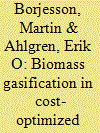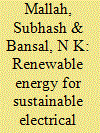|
|
|
Sort Order |
|
|
|
Items / Page
|
|
|
|
|
|
|
| Srl | Item |
| 1 |
ID:
094283


|
|
|
|
|
| Publication |
2010.
|
| Summary/Abstract |
This paper deals with MARKAL allocations for various energy sources, in India, for Business As Usual (BAU) scenario and for the case of exploitation of energy saving potential in various sectors of economy. In the BAU scenario, the electrical energy requirement will raise up to 5000 bKwh units per year or 752 GW of installed capacity with major consumers being in the industry, domestic and service sectors. This demand can be met by a mix of coal, hydro, nuclear and wind technologies. Other reneawbles i.e. solar and biomass will start contributing from the year 2040 onwards. By full exploitation of energy saving potential, the annual electrical energy demand gets reduced to 3061 bKwh (or 458 GW), a reduction of 38.9%.The green house gas emissions reduce correspondingly. In this scenario, market allocations for coal, gas and large hydro become stagnant after the year 2015.
|
|
|
|
|
|
|
|
|
|
|
|
|
|
|
|
| 2 |
ID:
150002


|
|
|
|
|
| Summary/Abstract |
National carbon mitigation policy included in the Clean Power Plan (CPP) targets electric power generation facilities and may have substantial impacts at the national level. The subnational impacts will vary because the level of dependence on coal for electricity generation varies substantially across states. Indiana represents a state where the CPP impacts may be relatively large due to heavy dependence on coal for electricity generation. Therefore, this paper presents analysis of the efficacy and cost of alternative approaches to carbon mitigation policy, taking Indiana as an example.
|
|
|
|
|
|
|
|
|
|
|
|
|
|
|
|
| 3 |
ID:
093481


|
|
|
|
|
| Publication |
2010.
|
| Summary/Abstract |
Biomass integrated gasification combined cycle (BIGCC) plants could, in combined heat and power (CHP) generation, increase the power-to-heat ratio compared to conventional biomass steam turbine plants. Furthermore, biomass gasification could also be used for the efficient production of biofuels for transport. In this study, different applications of biomass gasification in connection to district heating (DH) are analysed and contrasted to conventional technology options. An application of the cost-optimizing energy system model MARKAL with a detailed description of the DH sector in a southwestern region of Sweden was developed within the study and used in the analysis. Policy measures for CO2 reduction and for promotion of "green" electricity are assumed, and required subsidy levels for large-scale production of transport biofuels are calculated. The model also operates with different supplies of biomass: a local supply at a lower cost and an international supply of refined biomass at a slightly higher cost. The study shows that investments in BIGCC CHP are often cost-efficient in cases with low ambitions regarding transport biofuels. However, due to limitations in heat demand and in local, lower cost, supply of biomass, investment in biofuel production means less investment in BIGCC CHP and, thereby, a smaller electricity production.
|
|
|
|
|
|
|
|
|
|
|
|
|
|
|
|
| 4 |
ID:
103337


|
|
|
|
|
| Publication |
2011.
|
| Summary/Abstract |
This paper examines the impacts of CO2 emission reduction target and carbon tax on future technologies selection and energy use in Bangladesh power sector during 2005-2035. The analyses are based on a long-term energy system model of Bangladesh using the MARKAL framework. The analysis shows that Bangladesh will not be able to meet the future energy demand without importing energy. However, alternative policies on CO2 emission constraints reduce the burden of imported fuel, improve energy security and reduce environmental impacts. The results show that the introduction of the CO2 emission reduction targets and carbon taxes directly affect the shift of technologies from high carbon content fossil-based to low carbon content fossil-based and clean renewable energy-based technologies compared to the base scenario. With the cumulative CO2 emission reduction target of 10-20% and carbon tax of 2500 Taka/ton, the cumulative net energy imports during 2005-2035 would be reduced in the range of 39-65% and 37%, respectively, compared to the base scenario emission level. The total primary energy requirement would be reduced in the range of 4.5-22.3% in the CO2 emission reduction targets and carbon tax 2500 Taka/ton scenarios and the primary energy supply system would be diversified compared to the base scenario.
|
|
|
|
|
|
|
|
|
|
|
|
|
|
|
|
| 5 |
ID:
114326


|
|
|
|
|
| Publication |
2012.
|
| Summary/Abstract |
Bioenergy is an important renewable energy resource. However, assessments of the future of bioenergy are beset with uncertainty and contested values, suggesting that a precautionary approach to bioenergy resource development may be warranted.
This paper uses UK MARKAL to examine the implications of adopting a precautionary approach to bioenergy development in the UK. The paper reports a detailed review of UK bioenergy resources and sustainability constraints, and develops precautionary and optimistic resource scenarios. The paper then examines the implications of these scenarios using the energy systems model MARKAL, finding that a precautionary approach adds to the cost of decarbonisation, but does not significantly alter the optimal technology mix. In particular, biomass and co-firing CCS emerge as optimal technologies across scenarios.
The question of UK land availability for bioenergy production is highlighted within the paper. With less land available for bioenergy production, the costs of decarbonisation will rise; whereas if more land is available for bioenergy, then less land is available for either food production or ecosystem conservation. This paper quantifies one side of this trade-off, by estimating the additional costs incurred when UK land availability for bioenergy production is constrained.
|
|
|
|
|
|
|
|
|
|
|
|
|
|
|
|
| 6 |
ID:
110424


|
|
|
|
|
| Publication |
2011.
|
| Summary/Abstract |
The overall objective of this work is to identify the effects of climate change on the Norwegian energy system towards 2050. Changes in the future wind- and hydro-power resource potential, and changes in the heating and cooling demand are analysed to map the effects of climate change. The impact of climate change is evaluated with an energy system model, the MARKAL Norway model, to analyse the future cost optimal energy system. Ten climate experiments, based on five different global models and six emission scenarios, are used to cover the range of possible future climate scenarios and of these three experiments are used for detailed analyses. This study indicate that in Norway, climate change will reduce the heating demand, increase the cooling demand, have a limited impact on the wind power potential, and increase the hydro-power potential. The reduction of heating demand will be significantly higher than the increase of cooling demand, and thus the possible total direct consequence of climate change will be reduced energy system costs and lower electricity production costs. The investments in offshore wind and tidal power will be reduced and electric based vehicles will be profitable earlier.
|
|
|
|
|
|
|
|
|
|
|
|
|
|
|
|
| 7 |
ID:
097201


|
|
|
|
|
| Publication |
2010.
|
| Summary/Abstract |
Present trends of electrical energy supply and demand are not sustainable because of the huge gap between demand and supply in foreseeable future in India. The path towards sustainability is exploitation of energy conservation and aggressive use of renewable energy systems. Potential of renewable energy technologies that can be effectively harnessed would depend on future technology developments and breakthrough in cost reduction. This requires adequate policy guidelines and interventions in the Indian power sector. Detailed MARKAL simulations, for power sector in India, show that full exploitation of energy conservation potential and an aggressive implementation of renewable energy technologies lead to sustainable development. Coal and other fossil fuel (gas and oil) allocations stagnated after the year 2015 and remain constant up to 2040. After the year 2040, the requirement for coal and gas goes down and carbon emissions decrease steeply. By the year 2045, 25% electrical energy can be supplied by renewable energy and the CO2 emissions can be reduced by 72% as compared to the base case scenario.
|
|
|
|
|
|
|
|
|
|
|
|
|
|
|
|
| 8 |
ID:
098628


|
|
|
|
|
| Publication |
2010.
|
| Summary/Abstract |
This paper explores the prospects and policy implications for bioenergy to contribute to a long-term sustainable UK energy system.
The UK MARKAL technology-focused energy systems dynamic cost optimisation model-which has been used to quantify the costs and benefits of alternative energy strategies in UK policy making-is enhanced with detailed representation of bio-energy chains and end-uses. This provides an important advance in linking bioenergy expert-knowledge with a whole system modelling approach, in order to better understand the potential role of bioenergy in an evolving energy system.
The new BIOSYS-MARKAL model is used to run four scenarios constructed along the pillars of UK energy policy objectives (low carbon and energy security). The results are analysed in terms of bioenergy resources use and bioenergy pathways penetration in different end use sectors.
The main findings suggest that the complexity of different bioenergy pathways may have been overlooked in previous modelling exercises. A range of bioenergy pathways-notably bio-heat and biofuels for transport-may have a much wider potential role to play. The extent to which this potential is fulfilled will be further determined by resources availability, and market segment constraints, as well as policy measures to improve deployment.
|
|
|
|
|
|
|
|
|
|
|
|
|
|
|
|
|
|
|
|
|